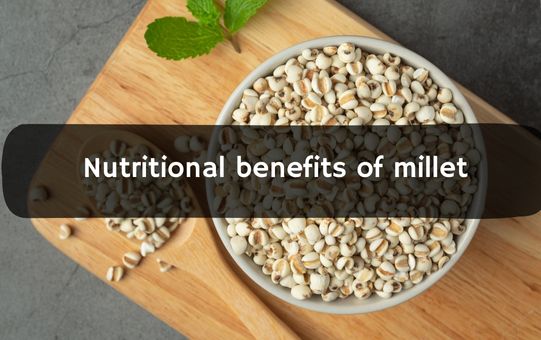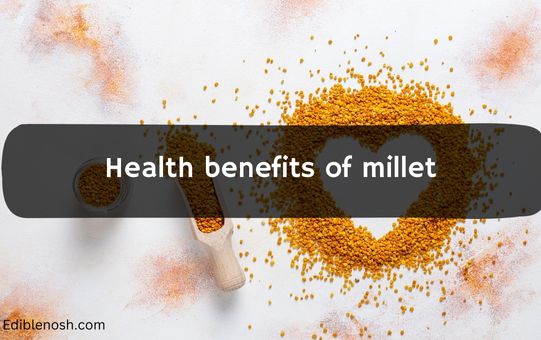Have you ever questioned why should we eat millets? Or perhaps you’re interested in learning more about millets’ nutritional benefits?
Millets are one of the earliest grains, which actually existed 10,000 years ago. People have been cultivating them more than thousands of years for use in food, medicines, and even clothing.
We will discuss millets in this article, including what they are, the best varieties, and the benefits of consuming them.
Contents
Why should we eat millet matter?
Millets are a group of small-seeded grasses that have been a staple food in many regions of the world for millennia. They are nutrient-dense foods with multiple health benefits.
They are gluten-free, high in fiber, which aids digestion and weight management, and abundant in essential nutrients such as B vitamins, iron, magnesium, and potassium. In addition, millets have a low glycemic index, making them an excellent choice for individuals with diabetes or prediabetes who need to manage their blood sugar levels.
Millets are a sustainable food option because they are drought-resistant and can be cultivated in low-fertility soils. Therefore, including millet in our diet is beneficial for maintaining a healthy and balanced diet.
Read Also: How To Tell If Millet Is Bad?
The nutritional benefits of millet
Millets are high in energy, protein, and carbohydrates, as well as essential minerals such as iron, magnesium, and potassium, as well as B3 vitamins.
| Nutrient | Amount per 100g |
|---|---|
| Energy | 373 kcal |
| Protein | 11 g |
| Fat | 3.5 g |
| Carbohydrates | 72 g |
| Fiber | 3.2 g |
| Iron | 2.8 mg |
| Magnesium | 168 mg |
| Phosphorus | 289 mg |
| Potassium | 160 mg |
| Zinc | 2.4 mg |
| Vitamin B3 (Niacin) | 2.2 mg |
In addition, millets are a good source of fiber, which can aid in digestion and weight management. Millets’ high magnesium content may also contribute to heart health and the maintenance of healthy blood sugar levels.
It is important to note that the values may vary depending on the millet variety and preparation method. Before adding new foods to your diet, it is always best to consult a healthcare professional if you are following a special diet or have certain health concerns.
The health benefits of millet
Millets are a group of small-seeded grasses that have been a staple food in many regions of the world for millennia. They are well-known for their nutritional value and numerous health advantages. Among the most important health benefits of millets are:

Gluten-free
Millets are gluten-free, making them an excellent option for individuals with gluten intolerance or celiac disease. Gluten is a protein found in wheat, barley, and rye that can cause intestinal inflammation and other health issues in gluten-sensitive individuals.
Good source of nutrients
Millets are an excellent source of numerous essential nutrients, including B vitamins, iron, magnesium, and potassium. In addition, they are rich in fiber, which can aid in digestion and weight management. In addition, millets are an excellent source of antioxidants, which protect the body from free radical damage.
Low glycemic index
Millets have a low glycemic index (GI), which means they do not cause a rapid increase in blood sugar levels. This makes them an excellent choice for people with diabetes or prediabetes who need to control their blood sugar levels.
Cardiovascular health
Millets are rich in magnesium, which is essential for maintaining heart health, and have been found to reduce blood pressure and the risk of heart disease.
Weight management
Millets’ high fiber content can help you feel fuller for longer, which can be advantageous for weight management.
Lowering cholesterol
The high fiber content of millet can aid in lowering bad cholesterol levels in the body, further promoting heart health.
Helping in digestion
Millets’ high fiber content aids digestion by preventing constipation and promoting regular bowel movements, thereby promoting overall digestive health.
Despite the fact that millet provides numerous health benefits, it should not be considered a miracle food. Eating a healthy and balanced diet consisting of a variety of nutrient-dense foods is the best way to maintain good health at all times.
Read Also: How To Eat Proso Millet?
How to Incorporate Millets into Your Diet?
There are numerous ways to include millet in one’s diet. Pearl millet, finger millet, and foxtail millet are popular millets. You can easily locate millets in any Indian or natural foods market.
Millet is most commonly prepared as a porridge-like dish that can be eaten for breakfast or as an evening snack. You can also substitute millet for rice in pilafs or make Rotis with millet flour. You can also substitute millet for rice in a salad.
How to cook millet?
Cooking millet is simple and can be accomplished in a few straightforward steps. Here’s one possible approach:
Rinse the millet
To remove any dirt or debris, first, rinse the millet in a fine-mesh strainer under cold running water.
Measure the millet and liquid
Determine the quantity of millet and liquid required. The general rule for most millet recipes is to use 2 cups of liquid per 1 cup of millet.
Bring the liquid to a boil
Bring the liquid (water, broth, or a combination) to a boil in a medium-sized pot over high heat.
Once the liquid has reached a boil, add the rinsed millet, reduce the heat to low, and stir the mixture.
Cover and simmer
Cover the pot with a lid that fits tightly and allow the millet to simmer for 20 to 25 minutes, or until the liquid has been absorbed and the millet is tender.
After the millet has cooked, remove the pot from the heat and let it rest for 5 minutes before fluffing and serving. The millet can then be fluffed with a fork and is ready to be served.
You can serve millet as a side dish or use it as the base for a pilaf, salad, or porridge-like dish. You can also use millet flour to make Rotis or bread dough, and you can combine it with various vegetable or meat recipes. There are numerous ways to experiment with millet and enjoy it.

can millet be eaten raw?
While it is possible to eat millet raw, it is not recommended to do so because of its tough texture and the presence of certain anti-nutrients that can make it difficult for the body to digest. Eating raw millet can be quite hard, and the outer layer of the grain contains phytic acid, which can interfere with the absorption of certain nutrients, such as calcium, zinc, and iron.
To make millet more digestible and palatable, it is typically cooked before consumption. Cooking millet also helps to break down the phytic acid, making it easier for the body to absorb the nutrients in the grain. Millet can be cooked using a variety of methods, such as boiling, steaming, or baking, and can be used in a wide range of dishes, from breakfast porridge to salads and pilafs.
Final Thought
Millets are a versatile, nutritious, and sustainable food option that can be a great addition to any diet. They are gluten-free, low on the glycemic index, a good source of several essential nutrients, and also environment-friendly.
Whether you’re looking to improve your health, reduce your carbon footprint, or simply add some variety to your meals, millets are a great option to consider.
FAQs | Should We Eat Millets
Following are the FAQs Related to should we eat millets:
What Are Millets And Where Do They Come From?
Millets are a group of small-seeded grasses that have been a staple food crop in many parts of the world for thousands of years. They are originally from Africa and Asia and are known for their nutritional value and health benefits.
What Are The Main Nutritional Benefits Of Millet?
Millets are a good source of essential nutrients such as B vitamins, iron, magnesium, and potassium.
They are also gluten-free and high in fiber and antioxidants, which can help with digestion, weight management, and protecting the body against damage from free radicals.
Can Millet Be Consumed By People With Gluten Intolerance Or Celiac Disease?
Yes, millets are gluten-free, making them a safe alternative for people with gluten intolerance or celiac disease. They can be used as a replacement for wheat, barley, and rye in many recipes.
How Do Millet Affect Blood Sugar Levels?
Millets have a low glycemic index, which means they do not cause a sharp spike in blood sugar levels.
This makes them a good option for people with diabetes or prediabetes, who need to manage their blood sugar levels. The high fiber content in millet also helps to slow down the absorption of sugar in the bloodstream.
How Can Millet Be Incorporated Into My Daily Diet?
Millets can be easily incorporated into your diet in a variety of ways. They can be used to make porridge, added to soups and stews, used to make Rotis, or added to salads. They can also be used in place of traditional grains like rice, barley, or quinoa. Experiment with different millet recipes to find the one that you like.

